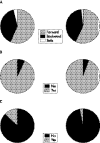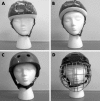Video analysis of falls experienced by paediatric iceskaters and roller/inline skaters
- PMID: 16505087
- PMCID: PMC2492006
- DOI: 10.1136/bjsm.2005.022855
Video analysis of falls experienced by paediatric iceskaters and roller/inline skaters
Abstract
Objectives: To evaluate differences in the way iceskaters and roller/inline skaters fall.
Methods: Children's falls related to skating were videotaped and categorised based on type of skating activity, child's estimated age, direction of fall, whether the child attempted to break the fall, and whether the head struck the skating surface.
Results: In total, 216 iceskating and 201 roller/inline skating falls were captured on videotape. In both iceskating and roller/inline skating, the majority of falls were forward in direction. The skaters attempted to break the falls with their arms or hands in over 90% of falls in both iceskating (93.1%) and roller/inline skating (94.5%). A greater proportion of falls in iceskating resulted in the head striking the skating surface (13.0%) than did those in roller/inline skating (3.0%) (odds ratio = 4.8; 95% confidence interval 1.9 to 13.3; p<0.001).
Conclusions: This study found that paediatric iceskaters and roller/inline skaters fall similarly and that both types of skaters try to break their falls with their arms or hands; however, because iceskating takes place on a low friction surface, attempts to break falls with the arms or hands are often unsuccessful, leading to head and face injuries. The development of a new type of protective gear, a wrist guard with a non-slip palm, should stop iceskaters from striking the head, protect against upper extremity fractures, and unlike a bulky helmet, should not discourage children from skating.
Conflict of interest statement
Competing interests: none
Similar articles
-
Differences in the risk associated with head injury for pediatric ice skaters, roller skaters, and in-line skaters.Pediatrics. 2006 Aug;118(2):549-54. doi: 10.1542/peds.2005-2913. Pediatrics. 2006. PMID: 16882806
-
Skateboarding: more dangerous than roller skating or in-line skating.Arch Pediatr Adolesc Med. 1998 Oct;152(10):985-91. doi: 10.1001/archpedi.152.10.985. Arch Pediatr Adolesc Med. 1998. PMID: 9790608
-
Children should wear helmets while ice-skating: a comparison of skating-related injuries.Pediatrics. 2004 Jul;114(1):124-8. doi: 10.1542/peds.114.1.124. Pediatrics. 2004. PMID: 15231918
-
[Injury patterns and prophylaxis in inline skating].Orthopade. 2005 May;34(5):441-7. doi: 10.1007/s00132-005-0794-9. Orthopade. 2005. PMID: 15856162 Review. German.
-
Preventing in-line skating injuries: how effective are the countermeasures?Sports Med. 1999 Nov;28(5):325-35. doi: 10.2165/00007256-199928050-00004. Sports Med. 1999. PMID: 10593645 Review.
Cited by
-
Epidemiology of Women's Flat Track Roller Derby Injuries in Kansas City.Mo Med. 2017 Jan-Feb;114(1):66-69. Mo Med. 2017. PMID: 30233105 Free PMC article.
-
Development and validation of a questionnaire for analyzing real-life falls in long-term care captured on video.BMC Geriatr. 2013 May 1;13:40. doi: 10.1186/1471-2318-13-40. BMC Geriatr. 2013. PMID: 23635343 Free PMC article. Clinical Trial.
-
Patients with ice hockey injuries presenting to US emergency departments, 1990-2006.J Athl Train. 2010 Sep-Oct;45(5):467-74. doi: 10.4085/1062-6050-45.5.467. J Athl Train. 2010. PMID: 20831391 Free PMC article.
-
Turbans vs. Helmets: A Systematic Narrative Review of the Literature on Head Injuries and Impact Loci of Cranial Trauma in Several Recreational Outdoor Sports.Sports (Basel). 2021 Dec 20;9(12):172. doi: 10.3390/sports9120172. Sports (Basel). 2021. PMID: 34941810 Free PMC article. Review.
-
Etiology and Biomechanics of Tarsometatarsal Injuries in Professional Football Players: A Video Analysis.Orthop J Sports Med. 2014 Mar 7;2(3):2325967114525347. doi: 10.1177/2325967114525347. eCollection 2014 Mar. Orthop J Sports Med. 2014. PMID: 26535306 Free PMC article.
References
-
- Boyce S H, Quigley M A. Rollerblading injuries in children attending an accident & emergency department: Should the use of wrist splints be compulsory? Scot Med J 200146102–103. - PubMed
-
- de Nooijer J, de Wit M, Steenhuis I. Why young Dutch inline skaters do (not) use protection equipment. Eur J Public Health 200414178–181. - PubMed
-
- American Academy of Pediatrics Committee on Injury and Poison Prevention and Committee on Sports Medicine and Fitness Inline skating injuries in children and adolescents. Pediatrics 1998101720–722. - PubMed
-
- Nguyen D, Letts M. Inline skating injuries in children: A 10‐year review. J Pediatr Orthop 200121613–618. - PubMed
Publication types
MeSH terms
LinkOut - more resources
Full Text Sources
Medical


